The Livestock Panel Gates Market is estimated to be valued at USD 11194.8 million in 2025 and is projected to reach USD 21014.2 million by 2035, registering a compound annual growth rate (CAGR) of 6.5% over the forecast period.
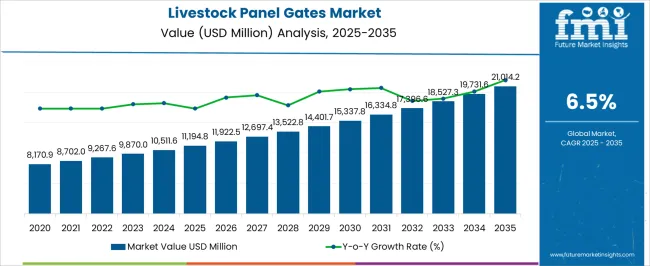
| Metric | Value |
|---|---|
| Livestock Panel Gates Market Estimated Value in (2025 E) | USD 11194.8 million |
| Livestock Panel Gates Market Forecast Value in (2035 F) | USD 21014.2 million |
| Forecast CAGR (2025 to 2035) | 6.5% |
The livestock panel gates market is experiencing steady growth as modern farming practices emphasize efficiency, safety, and durability in livestock management systems. Increasing herd sizes, the demand for better handling infrastructure, and the adoption of mechanized farming solutions have accelerated the need for strong and reliable panel gates.
Rising investments in agricultural infrastructure, coupled with government initiatives supporting livestock farming, are contributing to wider adoption. Advances in galvanized steel, modular designs, and customizable configurations are enhancing durability and operational flexibility, further driving market acceptance.
Additionally, biosecurity concerns and the need for animal welfare compliance are pushing farmers to invest in standardized and safer containment systems. With expanding livestock production across both developed and emerging economies, the market outlook remains positive, supported by consistent demand for robust, cost effective, and scalable panel gate solutions.
The market is segmented by Type, Height, and Application and region. By Type, the market is divided into Corral Panel Gates, Heavy-duty Panel Gates, and Heavy Panel Gates. In terms of Height, the market is classified into 38"/4 Bars, 48"/5 Bars, and 54"/6 Bars. Based on Application, the market is segmented into Livestock Industry, Private Farms, and Others. Regionally, the market is classified into North America, Latin America, Western Europe, Eastern Europe, Balkan & Baltic Countries, Russia & Belarus, Central Asia, East Asia, South Asia & Pacific, and the Middle East & Africa.
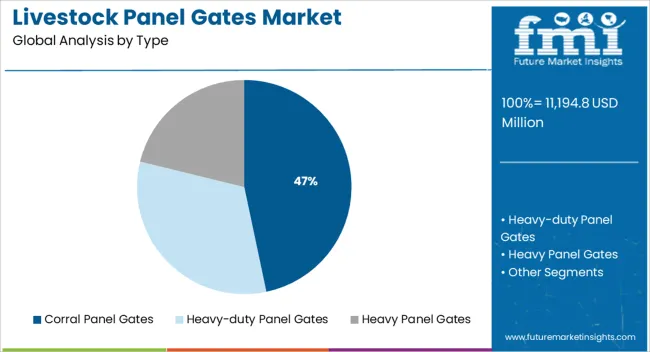
The corral panel gates segment is projected to hold 46.70% of the total market revenue by 2025 within the type category, making it the leading product segment. This dominance is supported by the widespread use of corral systems in livestock containment, offering flexibility, ease of installation, and durability in various farming conditions.
Their modular structure allows quick assembly and adaptability across different herd sizes, making them highly efficient for day to day livestock management.
Cost effectiveness and compatibility with multiple farming operations have further strengthened their position as the preferred choice in this category.
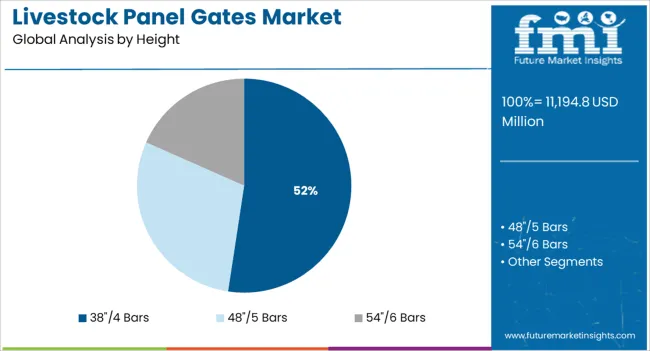
The 38"/4 bars segment is anticipated to account for 52.40% of the market by 2025 within the height category, establishing it as the dominant size configuration. This growth is attributed to its suitability for handling a wide range of livestock while ensuring ease of access, safety, and containment.
The height offers an optimal balance between animal control and handler convenience, supporting efficient farm operations.
Durability and reduced maintenance needs make this height option particularly attractive for large scale farms, reinforcing its strong market share.
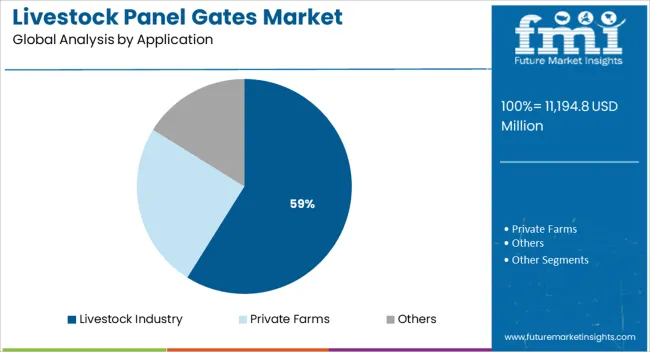
The livestock industry application segment is forecasted to capture 58.90% of overall market revenue by 2025, making it the most prominent application area. This leadership is driven by the rapid expansion of livestock farming, increased emphasis on safe animal handling, and regulatory standards promoting animal welfare.
The sector’s reliance on secure and durable infrastructure to manage growing livestock populations has intensified demand for high quality panel gates.
Continuous investment in modernizing farm facilities and ensuring efficient operations has established the livestock industry as the leading application segment within this market.
The market is expanding as a result of consumers' growing preference for livestock panel gates over conventional fencing systems.
When compared to the 5.8% CAGR recorded between 2020 and 2025, the livestock panel gates industry is predicted to expand at a 6.5% CAGR between 2025 and 2035. The average growth of the market is expected to be around 1.06x between 2025 and 2025.
| Market Statistics | Details |
|---|---|
| Market Share (2020) | USD 6,600.4 million |
| Market Share (2024) | USD 8,757.9 million |
| Market Share (2025) | USD 9,267.6 million |
Short-term Growth (2025 to 2029): the increased adoption of livestock panel gates in the agriculture sector leads to overall market growth in the short run.
Medium-term Growth (2035 to 2035): the need for safe surroundings for the animals and growing attention to animal welfare have increased demand for the panels.
Long-term Growth (2035 to 2035): long-term market growth is anticipated to be accelerated by the use of cutting-edge technology like automated gates, which offer improved control over animal movements.
The rising need for creative, automated gate solutions and the expanding use of smart gate technologies are two leading market trends. These are proved to be favorable for global market share.
Key players in the industry come up with new technologies to have a stronghold in the market. One of the key changes in technology is mobile app management.
Farmers are able to obtain information more quickly and conveniently due to the introduction of mobile apps in the livestock panel gates industry.
Livestock panel gates popularity is reaching heights, as mobile apps can give farmers immediate access to data about daily feed intake, and medical history. They may also offer guidance on how to use the gates to their greatest advantage, as well as crucial information about animal nutrition, health, and welfare.
Mobile apps can also assist farmers in inventory management and financial management, enabling them to make better decisions and increase productivity. Additionally, mobile apps can give farmers access to the most recent industry news and updates, enabling them to stay informed and seize new possibilities.
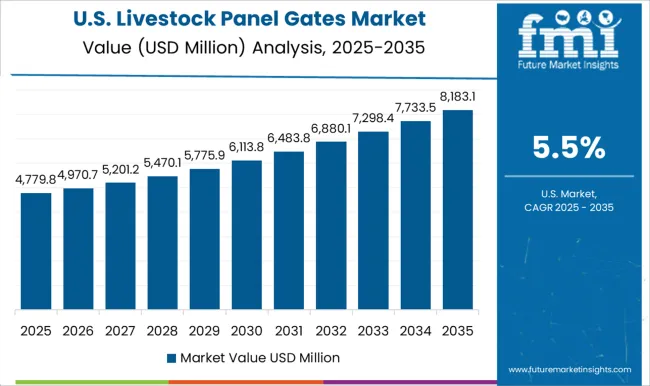
With a market share of 30.3% and a value of USD 2,810.9 million in 2025, the USA dominated the market. Several trends arise as individuals, companies, and manufacturers place a greater emphasis on sustainable materials, and the cost of living crisis looms larger.
A few changes are coming to the livestock panel gates sector in the USA, including stronger fences and eco-friendly finishes. The USA market is expected to increase due to the rising spending on animal husbandry and cutting-edge technology utilization in livestock management.
| Attributes | Statistics |
|---|---|
| United Kingdom Market Value 2025 | USD 869.9 million |
| United Kingdom Market Value 2035 | USD 1,707.1 million |
| United Kingdom Market Share (2025 to 2035) | 9.4% |
| United Kingdom Market CAGR (2025 to 2035) | 7% |
As part of its efforts to improve animal welfare, the United Kingdom government has also put rules into place that have promoted the use of livestock panel gates. Further increasing demand for these gates is the move toward larger-scale farming operations.
Manufacturers are investing in new production techniques and technology due to the increasing demand, giving farmers and ranchers access to a greater selection of possibilities. Additionally, companies now have an easier time finding the ideal gate for their purposes due to the availability of online purchasing.
| Country | China |
|---|---|
| Market Share (2025) | 8.7% |
| CAGR (2025 to 2035) | 5.2% |
| Market Value (2025) | USD 803.74 million |
| Market Value (2035) | USD 1,335.7 million |
| Country | India |
|---|---|
| Market Share (2025) | 3.7% |
| CAGR (2025 to 2035) | 7.6% |
| Market Value (2025) | USD 340.4 million |
| Market Value (2035) | USD 710.4 million |
To capitalize on the rising demand in China, businesses with experience producing livestock panel gates for the global market are well-positioned. Businesses concentrate on creating cutting-edge product designs that are specifically catered to Chinese consumers.
Companies are thinking about investing in marketing and distribution strategies that help them reach more potential customers, in addition to product development. To do this, customers can be targeted via digital marketing tools like social media and search engine marketing.
Trade exhibitions and other events can be used by businesses to promote their goods and create connections with important clients in the industry.
Over the past few years, the adoption of livestock panel gates has grown significantly in India. This can be ascribed to the rise in backyard farming and animal husbandry. The country's rising demand for livestock panel gates is due to their simplicity in installation and maintenance.
The increase in consumer disposable income has been a key factor in the market's increased demand. The government's attempts to support animal husbandry have also contributed to the rise in the popularity of these goods. The market is therefore anticipated to maintain its upward growth trajectory in the upcoming years.
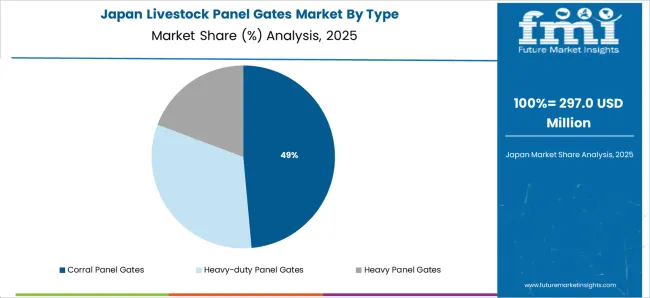
The Japanese livestock panel gates sector is a developing industry with lots of potential for new initiatives. With a share of 5.1% and a value of USD 475.1 million in 2025, Japan shows a significant growth in the market.
The following are some possible strategies that could be undertaken in this market.
With a share of 2.6% and a value of USD 243.1 million in 2025, Australia shows a significant growth in the market. Initiatives taken by the Australian government to encourage the demand for livestock panel gates include offering subsidies and grants.
The market is anticipated to increase as consumers' interest in natural and organic products and their concern for animal welfare grow. However, it is projected that the high cost of installation and maintenance for livestock panel gates may in some ways restrain the market growth. Additionally, it is projected that the lack of product awareness in some rural areas can constrain market growth.
A novel self-closing livestock panel gate that can be remotely opened and closed using a smartphone or tablet has been created by an Australian business. The system is made to speed up the process of opening and closing gates, while also adding a higher level of protection.
In terms of application, the market's dominating segment is projected to be the livestock industry segment. The livestock industry's increasing need for a professional and skilled workforce is projected to provide the profitable potential for market expansion.
The expanding trend of animal nutrition and the rising demand for high-quality animal feed are also anticipated to boost the global market growth.
The livestock panel gates sector is dominated by heavy-duty panel gates. These gates can support the weight of huge animals and are built to resist heavy and regular use. They are built of materials with excellent strength and are intended to last for many years.
They often come with a powder coating for added defense against the weather and come in a range of colors, which makes it an attractive option for consumers. To make installation and handling simpler, manufacturers include a variety of accessories like gate locks, hinges, and guide rails.
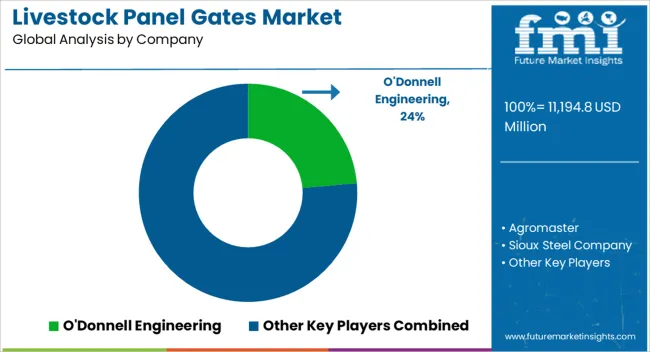
How New-entrants Benefit the Livestock Panel Gates Manufacturers?
During the forecast period, start-ups in the livestock panel gates business are seeing fresh opportunities in the industry. This is a result of farmers and ranchers looking for more affordable alternatives to conventional fence systems, increasing their demand for livestock panel gates.
It is becoming simpler for business owners to enter the market due to the increase in livestock panel gate producers and distributors. Recently, start-ups are entering the market with innovative products. Key start-ups that are now on the market include:
In recent years, there has been a lot of innovation in the livestock panel gates industry. To improve the efficiency and dependability of their products, manufacturers are investing in innovative technology.
These include enhanced materials and design elements that make the gates more enduring and simple to install, as well as security features like automatic locking mechanisms and sensors.
Livestock panel gate producers are spending money on research and development to develop innovative gate designs that are suited to the needs of particular animals. Included in this are gates with adjustable widths, heights, and other customizing choices. Finally, some manufacturers are now providing wireless solutions that let farmers watch and manage the gates from a distance.
Notable Developments in the Industry:
The global livestock panel gates market is estimated to be valued at USD 11,194.8 million in 2025.
The market size for the livestock panel gates market is projected to reach USD 21,014.2 million by 2035.
The livestock panel gates market is expected to grow at a 6.5% CAGR between 2025 and 2035.
The key product types in livestock panel gates market are corral panel gates, heavy-duty panel gates and heavy panel gates.
The global livestock panel gates market is estimated to be valued at USD 11,194.8 million in 2025.
The market size for the livestock panel gates market is projected to reach USD 21,014.2 million by 2035.
The livestock panel gates market is expected to grow at a 6.5% CAGR between 2025 and 2035.
The key product types in livestock panel gates market are corral panel gates, heavy-duty panel gates and heavy panel gates.
In terms of height, 38/4 bars segment to command 52.4% share in the livestock panel gates market in 2025.






Our Research Products

The "Full Research Suite" delivers actionable market intel, deep dives on markets or technologies, so clients act faster, cut risk, and unlock growth.

The Leaderboard benchmarks and ranks top vendors, classifying them as Established Leaders, Leading Challengers, or Disruptors & Challengers.

Locates where complements amplify value and substitutes erode it, forecasting net impact by horizon

We deliver granular, decision-grade intel: market sizing, 5-year forecasts, pricing, adoption, usage, revenue, and operational KPIs—plus competitor tracking, regulation, and value chains—across 60 countries broadly.

Spot the shifts before they hit your P&L. We track inflection points, adoption curves, pricing moves, and ecosystem plays to show where demand is heading, why it is changing, and what to do next across high-growth markets and disruptive tech

Real-time reads of user behavior. We track shifting priorities, perceptions of today’s and next-gen services, and provider experience, then pace how fast tech moves from trial to adoption, blending buyer, consumer, and channel inputs with social signals (#WhySwitch, #UX).

Partner with our analyst team to build a custom report designed around your business priorities. From analysing market trends to assessing competitors or crafting bespoke datasets, we tailor insights to your needs.
Supplier Intelligence
Discovery & Profiling
Capacity & Footprint
Performance & Risk
Compliance & Governance
Commercial Readiness
Who Supplies Whom
Scorecards & Shortlists
Playbooks & Docs
Category Intelligence
Definition & Scope
Demand & Use Cases
Cost Drivers
Market Structure
Supply Chain Map
Trade & Policy
Operating Norms
Deliverables
Buyer Intelligence
Account Basics
Spend & Scope
Procurement Model
Vendor Requirements
Terms & Policies
Entry Strategy
Pain Points & Triggers
Outputs
Pricing Analysis
Benchmarks
Trends
Should-Cost
Indexation
Landed Cost
Commercial Terms
Deliverables
Brand Analysis
Positioning & Value Prop
Share & Presence
Customer Evidence
Go-to-Market
Digital & Reputation
Compliance & Trust
KPIs & Gaps
Outputs
Full Research Suite comprises of:
Market outlook & trends analysis
Interviews & case studies
Strategic recommendations
Vendor profiles & capabilities analysis
5-year forecasts
8 regions and 60+ country-level data splits
Market segment data splits
12 months of continuous data updates
DELIVERED AS:
PDF EXCEL ONLINE
Wire Livestock Panels Market Size and Share Forecast Outlook 2025 to 2035
Panel Mount EMI Filter Market Forecast and Outlook 2025 to 2035
Panel Saw Market Size and Share Forecast Outlook 2025 to 2035
Livestock Trailer Market Size and Share Forecast Outlook 2025 to 2035
Panel Mounted Disconnect Switch Market Size and Share Forecast Outlook 2025 to 2035
Panel Level Packaging Market Analysis by Materials and Technologies Through 2025 to 2035
Livestock Monitoring System Market
Dog Gates, Doors, & Pens Market Analysis - Trends, Growth & Forecast 2025 to 2035
Competitive Overview of Dog Gates, Doors and Pens Companies
Flat Panel Antenna Market Size and Share Forecast Outlook 2025 to 2035
Ring Panel Filters Market Size and Share Forecast Outlook 2025 to 2035
Flat Panel Display Market Analysis by Technology, Application, and Region through 2025 to 2035
Flat Panel X-Ray Detectors Market Analysis by Application, Product, and Region Forecast Through 2035
Market Share Distribution Among Ring Panel Filters Providers
Wood Panel Market
Solar Panel Market Size and Share Forecast Outlook 2025 to 2035
Solar Panel Recycling Management Market Size and Share Forecast Outlook 2025 to 2035
Solar Panel Cleaning Market Size and Share Forecast Outlook 2025 to 2035
Touch Panel Market Size and Share Forecast Outlook 2025 to 2035
Solar Panel Mounting Structures Market Growth - Trends & Forecast 2025 to 2035

Thank you!
You will receive an email from our Business Development Manager. Please be sure to check your SPAM/JUNK folder too.
Chat With
MaRIA